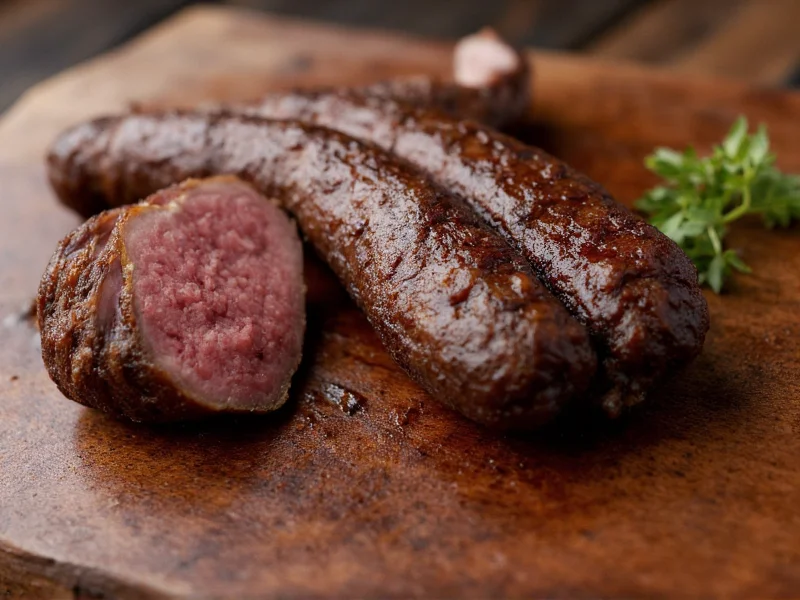Understanding what black sausage is requires exploring its rich culinary history and diverse regional variations. This distinctive food item represents one of the oldest forms of sausage preparation, dating back to ancient civilizations that developed methods to preserve blood, which spoils quickly after animal slaughter.
The Essential Components of Black Sausage
At its core, black sausage contains three fundamental ingredients that create its characteristic texture and appearance:
- Animal blood – Usually pork blood, though some regional varieties use cow or sheep blood
- Fat – Typically pork fat that provides moisture and richness
- Filler/binder – Oats, barley, breadcrumbs, or rice that absorbs the blood and creates structure
Additional ingredients vary significantly by region but often include onions, spices (like pepper, cloves, or allspice), and sometimes dried fruits or nuts. The blood is mixed with near-boiling liquid to prevent coagulation before combining with other ingredients, then stuffed into casings and cooked.
Global Variations of Black Sausage
What is black sausage in one country might differ substantially from another. This culinary tradition has evolved uniquely across different cultures:
| Regional Name | Country/Region | Distinctive Characteristics |
|---|---|---|
| Black Pudding | United Kingdom, Ireland | Uses pig's blood with oatmeal or barley; often includes onions and spices |
| Morcilla | Spain, Latin America | Spanish version often includes rice and paprika; Latin American versions may contain garlic and peppers |
| Blodpølse | Scandinavia | Contains rye flour or barley; traditionally served with boiled potatoes and lingonberry jam |
| Kaszanka | Poland, Eastern Europe | Made with pork blood and buckwheat; often includes pork liver and fat |
| Dinuguan | Philippines | Stew rather than sausage; features pig's blood, meat, and vinegar |
What Makes Black Sausage Different From Other Sausages
The defining characteristic that answers “what is black sausage” lies in its primary ingredient – animal blood. While most sausages rely on meat and fat as their foundation, black sausage uses blood as the key component that gives it both color and distinctive flavor.
Unlike fresh sausages that require cooking before consumption, many black sausages are pre-cooked during manufacturing, making them ready to eat after simple reheating. The texture ranges from soft and spreadable (in some fresh versions) to firm and sliceable (in cured varieties).
Nutritional Profile of Black Sausage
Understanding what black sausage nutritionally offers helps explain its historical importance as a survival food. A typical 100g serving of black pudding contains:
- Approximately 250-300 calories
- 15-20g of protein
- High iron content (from the blood) – often exceeding 50% of daily recommended intake
- Significant amounts of zinc and vitamin B12
- Relatively high fat content (15-25g)
This nutritional profile made black sausage particularly valuable in historical contexts where iron deficiency was common. The blood provides heme iron, which is more readily absorbed by the human body than non-heme iron from plant sources.
Traditional Preparation Methods
The process of making black sausage has remained remarkably consistent throughout history, though modern production has introduced some variations. Traditional preparation involves:
- Collecting fresh animal blood and mixing it with a small amount of vinegar or salt to prevent premature coagulation
- Cooking the filler ingredient (oats, barley, or rice) separately
- Combining the blood with cooked filler, fat, and seasonings
- Stuffing the mixture into natural or synthetic casings
- Boiling or steaming the sausages to cook them through
- Optionally smoking or curing for preservation
Modern commercial production often uses food-grade citrates as anticoagulants and may include additional preservatives, but artisanal producers typically stick to traditional methods when creating authentic black sausage.
How Black Sausage Is Served Around the World
The versatility of black sausage explains its enduring popularity across diverse culinary traditions. Common serving methods include:
- Breakfast component – Sliced and fried as part of a full English or Irish breakfast
- Appetizer – Sliced thin and served with bread or crackers, sometimes with fruit chutney
- Main course – Paired with apples, potatoes, or lentils in various European cuisines
- Ingredient – Crumbled into stuffings, added to stews, or used to flavor sauces
In Spain, morcilla often appears tapas bars served with a drizzle of olive oil. In Scotland, black pudding is sometimes battered and deep-fried. Filipino dinuguan is served as a stew with rice. These diverse preparations showcase how different cultures have adapted black sausage to their local tastes.
Finding and Selecting Quality Black Sausage
For those wondering where to find authentic black sausage, options include:
- Specialty butcher shops, particularly those focusing on European or regional cuisines
- International grocery stores (look for Spanish, Irish, or Eastern European sections)
- Some mainstream supermarkets, especially in the UK and Ireland
- Online specialty food retailers
When selecting black sausage, look for products with simple ingredient lists that emphasize traditional components. The best black pudding or morcilla will list blood as one of the first ingredients, with recognizable grains and spices. Avoid products with excessive preservatives or artificial ingredients if seeking an authentic experience.
Cooking With Black Sausage
Understanding what black sausage brings to dishes helps home cooks incorporate it effectively. When cooking with black sausage:
- Remember that most varieties are already cooked, so they only need reheating
- Frying creates a delicious crispy exterior while maintaining a soft interior
- Pair with sweet elements like apples, pears, or dried fruits to balance the iron-rich flavor
- Complement with acidic components like vinegar-based sauces to cut through the richness
- Use as a flavor enhancer in stuffings, sauces, or even burger blends
A simple preparation method that showcases traditional black sausage involves slicing it 1-2cm thick, pan-frying until crispy on both sides, and serving with mashed potatoes and caramelized onions – a preparation common across Northern Europe.











 浙公网安备
33010002000092号
浙公网安备
33010002000092号 浙B2-20120091-4
浙B2-20120091-4